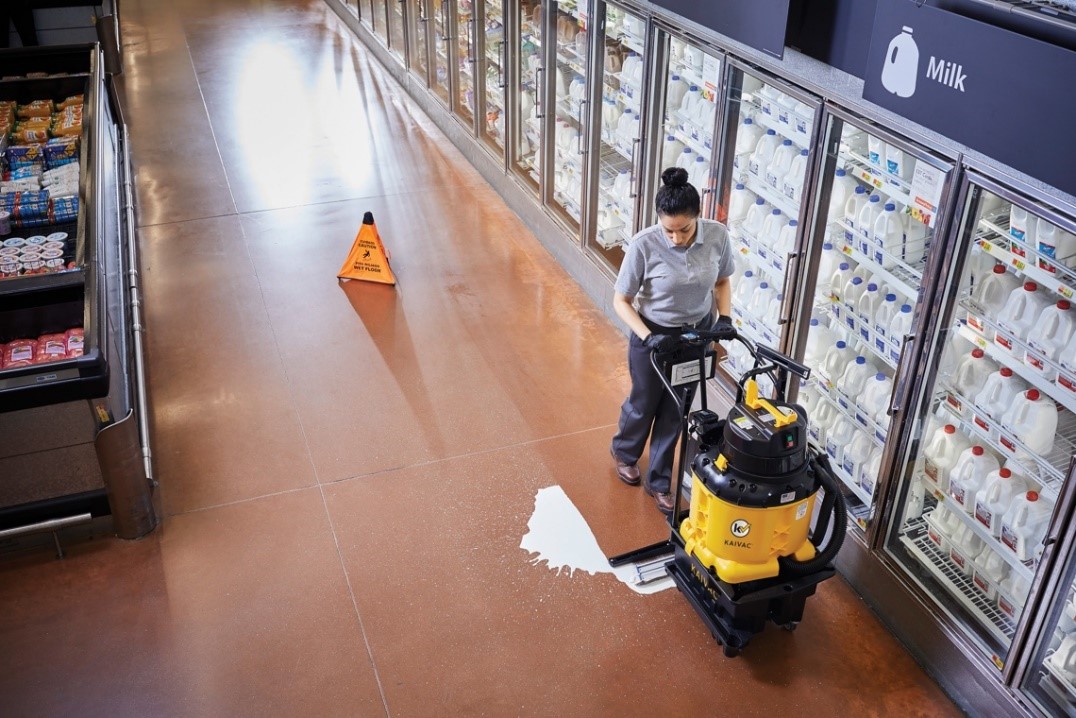Rawlins’ Kaivac AutoVac Stretch™ empowers sustainable floor cleaning

Rawlins’ Kaivac’s AutoVac Stretch™ hard floorcare machine has earned Green Seal’s Certification of Environmental Innovation. The certification has been awarded based on reduced environmental toxicity, waste minimisation, use of verified environmentally preferable products, and conservation of energy and water. To earn this four-year certification, Kaivac’s AutoVac Stretch met a rigorous standard for transformative product innovation.
“Kaivac systems empower green cleaning efforts with high production rates and verifiable results,” says Werner du Plessis, MD of Rawlins, which is based in Maybrook Road, Sutton Coldfield. “With a high-flow fluid extraction method, Kaivac’s AutoVac Stretch uses at least 65% per cent less water and cleaning solution than competitors. The machine’s unique recycling function filters and reuses cleaning solution up to seven times, conserving water and reducing pollution without compromising cleaning performance. For example, AutoVac Stretch cleans up to 1,000 square feet per litre of water, while most floor scrubbers and scrubber driers clean only roughly 150 square feet per litre.”
Green Seal CEO Doug Gatlin says: “Modern environmental challenges demand modern solutions, including commercial cleaning equipment that is better for the planet while delivering the highest performance in cleaning and user ergonomics. That’s why Green Seal’s Environmental Innovation Standard measures improved health and environmental outcomes, not just material inputs. Kaivac, from Rawlins, has raised the bar for what buyers should expect about the sustainability of high-performance cleaning equipment in the marketplace.”
The AutoVac Stretch delivers cleaner, shinier floors. It features extreme soil removal technology, combined with a quick-change Lithium-ion Power Pack and unique single-fill recycling option. This enables an unprecedented cleaning range in a walk-behind machine, without loss of cleaning effectiveness.
Low cost of ownership
“Kaivac’s AutoVac Stretch offers autoscrubber performance at around one fifth of the cost of a typical 32″ riding autoscrubber, and delivers considerably greater cleaning range between fill-ups,” says Werner du Plessis. “Kaivac’s extreme soil removal technology enables users to reuse or recycle the cleaning solution without loss of cleaning effectiveness, conserving water by 75% or more, while reducing chemical usage by 66% or more. So you can see why AutoVac Stretch™ represents a real breakthrough in sustainable floor cleaning.”
Kaivac’s AutoVac Stretch™ is ideal for daily cleaning but can also be used for stripping and finishing floors. It ensures faster cleaning, and due to its unique one-fill process, independent performance tests show that users can clean more than 25,000 square feet per hour by eliminating unnecessary trips to refill. Plus, most users can skip dust mopping and trail mopping for even greater productivity.
In tests performed by a major university, the AutoVac™ system removed up to 99.8 per cent of targeted soil. This was slightly better than an autoscrubber, which removed up to 99.4 per cent. A brand-new microfibre mop only removed 50.9 per cent. Plus, in gloss meter testing, the system’s gentle, non-abrasive cleansing action resulted in approximately 25 per cent shinier floors.
“Another huge benefit is that the AutoVac™ Stretch™ is really easy to use and features the KaiTutor™ onboard video training system,” says Werner du Plessis. “And for me, the best part is the machine’s extremely low cost of ownership. For starters, the initial purchase price is about 70-80 per cent less than an equivalently sized autoscrubber, and in many cases it is less than an autoscrubber’s average annual maintenance cost. Add to that greatly improved productivity, major chemical saving and 65 per cent lower maintenance costs all make for a very quick return on investment.
“With so few moving parts, there is little that can go wrong, and if it does, it’s so easy to troubleshoot and fix, unlike most cleaning equipment. Even better, the system doesn’t require a technician to maintain or fix. In most cases, an entire unit can be reconditioned in minutes for less than the cost of a single service call.”






